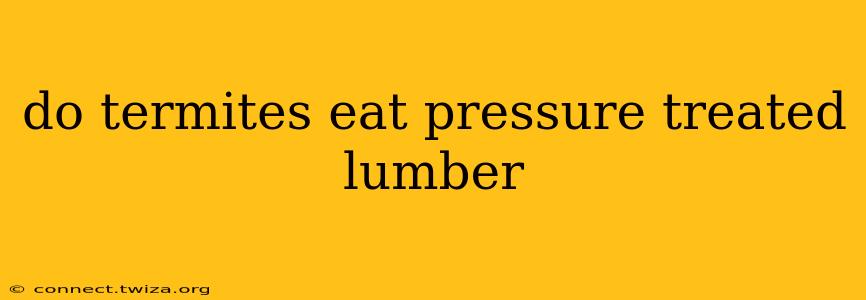Do Termites Eat Pressure Treated Lumber? A Deep Dive into Wood Protection
Pressure-treated lumber has long been a staple in construction projects, offering a significant advantage against rot and decay. But the burning question for many homeowners and builders is: Do termites eat pressure treated lumber? The short answer is more nuanced than a simple yes or no.
While pressure-treated lumber is significantly more resistant to termite damage than untreated wood, it's not entirely immune. The effectiveness depends on several crucial factors, and understanding these is key to protecting your investment.
What Chemicals are Used in Pressure Treated Lumber?
Pressure-treated lumber is infused with preservatives under high pressure, penetrating deep into the wood's cellular structure. The most common preservatives used include:
- Chromated Copper Arsenate (CCA): While highly effective, CCA contained arsenic, leading to its phase-out in residential applications. You're less likely to find CCA-treated lumber in newer constructions.
- Copper Azole (CA-B): This is a common replacement for CCA and is considered less toxic. It's effective against both decay and insects.
- Copper Quaternary Ammonium (CA-C): Another alternative to CCA, CA-C offers similar protection.
How Effective is Pressure Treatment Against Termites?
The effectiveness of pressure-treated lumber against termites depends on several factors:
- Type of Preservative: CCA-treated lumber historically provided the strongest protection against termites, but its toxicity concerns led to its phasing out. CA-B and CA-C are still highly effective but may not offer the same level of protection as CCA.
- Concentration of Preservative: The amount of preservative infused into the wood directly impacts its resistance. Higher concentrations generally provide better protection.
- Type of Termite: Subterranean termites, the most common type, are generally deterred by pressure-treated lumber. However, some species may still be able to feed on it, especially if the preservative has leached out over time or the concentration was low. Formosan subterranean termites, known for their aggressive feeding habits, pose a greater threat. Drywood termites, which live within the wood itself, may also be less affected.
- Condition of the Lumber: Damage to the pressure-treated lumber, such as cracks or exposed areas, can create entry points for termites, reducing its effectiveness. Exposure to the elements can also cause the preservative to leach out, decreasing protection over time.
- Age of the Lumber: Over time, the preservative can leach out of the wood, reducing its effectiveness. Older pressure-treated lumber is more susceptible to termite infestation.
What About Ground Contact?
Pressure-treated lumber is often used in situations involving ground contact, such as decks, fences, and retaining walls. However, even with pressure treatment, prolonged ground contact can lead to leaching of the preservative and increase the risk of termite infestation. Proper ventilation and ensuring the wood isn't constantly in direct contact with damp soil are crucial.
Are there Alternatives to Pressure Treated Lumber?
Yes, there are alternative materials you can consider that offer termite resistance:
- Cedar: Naturally resistant to decay and insects.
- Redwood: Also naturally resistant to decay and insects.
- Composite Lumber: Made from recycled materials and designed to resist decay and insect damage.
Can Termites Still Infest Pressure Treated Wood?
While less likely, it's important to remember that yes, termites can still infest pressure-treated wood under certain conditions. Regular inspections, especially in areas with high termite activity, are essential. Early detection is key to preventing significant damage.
This detailed exploration addresses the complexities surrounding the interaction between termites and pressure-treated lumber, providing a comprehensive understanding to help you make informed decisions for your construction and home protection needs. Remember, regular inspections and proactive pest control measures are always recommended.
